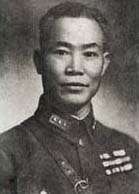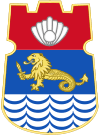Chen Cheng
| Chen Cheng | |
|---|---|
| 陳誠 | |
 | |
| Vice President of the Republic of China | |
|
In office 20 May 1954 – 5 March 1965 | |
| President | Chiang Kai-shek |
| Preceded by | Li Tsung-jen |
| Succeeded by | Yen Chia-kan |
| 5th & 7th Premier of the Republic of China | |
|
In office 7 March 1950 – 7 June 1954 | |
| President | Chiang Kai-shek |
| Vice Premier |
Chang Li-sheng Huang Shao-ku |
| Preceded by | Yü Hung-chün |
| Succeeded by | Yen Hsi-shan |
|
In office 30 June 1958 – 15 December 1963 | |
| President | Chiang Kai-shek |
| Vice Premier |
Huang Shao-ku Wang Yun-wu |
| Preceded by | Yü Hung-chün |
| Succeeded by | Yen Chia-kan |
| 2nd Chairman of Taiwan Provincial Government | |
|
In office 5 January 1949 – 21 December 1949 | |
| President |
Chiang Kai-shek Li Tsung-jen |
| Preceded by | Wey Daw-ming |
| Succeeded by | Wu Kuo-Chen |
| 1st Chief of the General Staff of the Republic of China Armed Forces | |
|
In office 23 March 1946 – 12 May 1948 | |
| President | Chiang Kai-shek |
| Preceded by | Position established |
| Succeeded by | Gu Zhutong |
| 1st Commander-in-Chief of the Republic of China Navy | |
|
In office 1 July 1946 – 25 August 1948 | |
| President | Chiang Kai-shek |
| Preceded by | Position established |
| Succeeded by | Kui Jung-ching |
| Personal details | |
| Born |
January 4, 1897 Qingtian, Zhejiang, Qing dynasty |
| Died |
March 5, 1965 (aged 68) Taipei, Taiwan |
| Nationality |
|
| Political party |
|
| Spouse(s) | Tan Xiang |
| Relations | Tan Yankai (father-in-law) |
| Occupation | Politician |
| Awards | Order of Blue Sky and White Sun |
| Military service | |
| Nickname(s) | Little Generalissimo |
| Allegiance |
|
| Service/branch | Republic of China Army |
| Years of service | 1924–1950 |
| Rank | General |
| Unit | 11th division |
| Commands |
18th Army 11th Division |
| Battles/wars | |
Chen Cheng (Chinese: 陳誠; pinyin: Chén Chéng; January 4, 1897 – March 5, 1965) was a Chinese political and military leader, and one of the main National Revolutionary Army commanders during the Second Sino-Japanese War and the Chinese Civil War. After moving to Taiwan at the end of the civil war, he served as the Governor of Taiwan Province, Vice President and Premier of the Republic of China (ROC). He represented the ROC in visits to the United States. He also helped to initiate land reforms and tax reduction programs that caused Communism to become unattractive in Taiwan, where peasants were able to own land. His alias was Chen Tsyr-shiou (陳辭修; Chén Cíxiū).
Biography
Early life
Chen Cheng was born in Qingtian County, Zhejiang, he was graduated from Baoding Military Academy in 1922, and entered Whampoa Academy two years later. It is here where he met Chiang Kai-shek for the first time, Then Commandant of the Academy. Later, Chen joined National Revolutionary Army to participate in the Northern Expedition.
Rise in the military
During the Northern Expedition, Chen displayed his excellent leadership ability. Within a year of conquest, he was promoted from commanding battalions to divisions already.
Later after the expedition, Chen became active in the wars against warlords. His successes in these battles allowed him to be promoted again, this time to the commander of the 18th Army.
Anti-Communist campaigns
Beginning in 1931, Chen was assigned the task of suppressing the Red Army. In various campaigns searching for the main force of Red Army, Chen's units experienced heavy casualties. In the fifth campaign against the Communists, he finally managed to defeat them, forcing the Red Army to launch their epic Long March.
Campaigns against the Red Army came to an end after the Xi'an Incident, which Chiang and his staffs were forced to agree in cooperation with the Communists against the invading Japanese Army.
War against Japan
During the Battle of Shanghai he was one of the top military assistants of Chiang Kai Shek. It was his idea to seek a decisive action in the south rather than confront the Japanese in Northern China where nationalist troops were in poor condition and lacked transporting vehicles. After the fall of Shanghai and Nanjing, Chen moved to Hubei to command the Battle of Wuhan during the year of 1938. Wuhan was the provisional headquarters of the Chinese Army. The Japanese however, managed to defeat the Chinese, albeit suffering heavy losses, and captured Wuhan on October 25, 1938.
In the latter years of the war, Chen went on to command in the Battle of Changsha, Battle of Yichang and Battle of West Hubei. In 1943, he was appointed the commander of the Chinese Expeditionary Force in the Burma theatre until he was replaced by Wei Li-huang due to illness.
Chinese Civil War
After the Second Sino-Japanese War, Chen became the Chief of the General Staff and commander-in-chief of the navy. He followed Chiang's orders and began to raid the "liberated" areas of the Red Army which launched the Chinese Civil War.
In August 1947, Chiang appointed Chen as director of the Northeastern Headquarters to command the Nationalist forces against the Communists in that area.[1] He made the crucial mistake of dissolving the local security regiments, because they served in the Japanese-collaborationist Manchukuo Imperial Army, as a result of which the total Nationalist strength in Manchuria fell from 1.3 million to less than 480,000. He also dismissed some of the most capable nationalist commanders, such as Du Yuming, Sun Li-jen, Zheng Dongguo and Chen Mingren. As a result, he suffered a series of major defeats and Chiang Kai-shek recalled Chen to Nanjing and sent Wei Lihuang to replace him in Shenyang as commander-in-chief of the northeast and Fan Hanjie as deputy commander-in-chief and director of Jinzhou forward command center.[2] Chen took a sick leave in Taiwan to treat his chronic stomach ailment.
In Taiwan
Chiang appointed Chen as the Governor of Taiwan Province in 1949 to plan the development of Taiwan as one of the strongholds of the Kuomintang. After the Nationalist force retreated to Taiwan, Chen went on to hold key civilian government positions such as Vice-Executive of the Kuomintang, Vice President and Premier of the Republic of China.
In his years on Taiwan, he introduced various land and economic reforms and carried out the reconstruction of Taiwan. He kept communists off Taiwan by allowing farmers to actually own land they tilled. The original landlords were issued stocks from enterprises which belonged to the government. He was also credited with launching several earlier construction projects. One was the Shimen Reservoir which reduced flooding while increasing rice crop production.
On May 19, 1949, Chen promulgated the “Order of Martial Law” to announce the imposition of martial law throughout Taiwan. He was the instigator of the "White Terror" in Taiwan, responsible for the execution of educators who tried to protect their students from forced conscription. Dozens of educators and students were executed as the result, and the victims' families were black-listed for-life.
Chen died of hepatic tumors in 1965. His cremated remains were moved to Fo Guang Shan, Kaohsiung County (now part of Kaohsiung City) in August 1995. His son tried to run for President of Taiwan and participated in education and politics.
Family
He married Tan Xiang, the daughter of Tan Yankai, the former Chinese Premier. Chen and Tan's eldest son, Chen Li-an, also became a politician and ran unsuccessfully in the presidential elections.
Honors
Key to the City
 Manila, Philippines (March 20, 1960)[3]
Manila, Philippines (March 20, 1960)[3] Pasay City, Philippines (March 20, 1960)[4]
Pasay City, Philippines (March 20, 1960)[4]
See also
References
- ↑ Law, Debbie (2011). "Chen Cheng (Ch'en Ch'eng) (1898–1965)". ABC-CLIO.
- ↑ Taylor, Jay (2009). The Generalissimo: Chiang Kai-shek and the Struggle for Modern China. Harvard University Press. p. 381.
- ↑ "Cementing Philippines Friendship". Taiwan Today.
- ↑ "Cementing Philippines Friendship". Taiwan Today.
| Wikimedia Commons has media related to Chen Cheng. |
- Dupuy, Trevor N. Harper Encyclopedia of Military Biography, New York, 1992
- http://www.generals.dk/general/Chen_Cheng/_/China.htmlWu[] Kuo-Chen
- Ministry of National Defense R.O.C
- US Naval War College
- http://cgsc.leavenworth.army.mil/carl/download/csipubs/bjorge_huai.pdf
| Political offices | ||
|---|---|---|
| Preceded by Wey Daw-ming |
Governor of Taiwan Province January 5, 1949 – December 21, 1949 |
Succeeded by Wu Kuo-Chen |
| Government offices | ||
| Preceded by Yen Hsi-shan |
Premier of the Republic of China March 7, 1950 – June 7, 1954 |
Succeeded by Yü Hung-chün |
| Preceded by Yü Hung-chün |
Premier of the Republic of China June 30, 1958 – December 15, 1963 |
Succeeded by Yen Chia-kan |
| Preceded by Li Tsung-jen |
Vice President of the Republic of China March 12, 1954 – March 5, 1965 |
Succeeded by Yen Chia-kan |
| Preceded by Position established |
Chief of the General Staff of the Republic of China Armed Forces March 23, 1946 – Mary 12, 1948 |
Succeeded by Gu Zhutong |